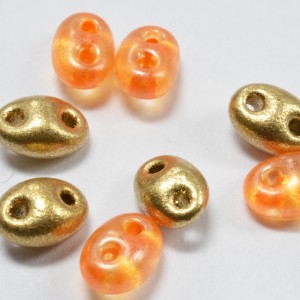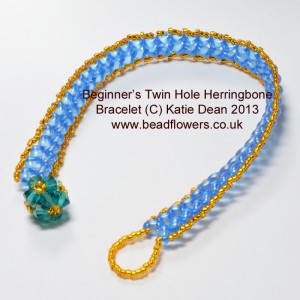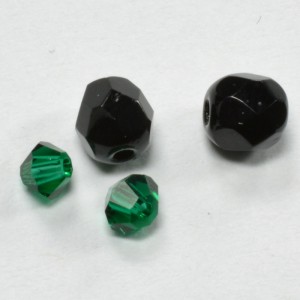Making Bead Substitutions
I see a lot of questions about making bead substitutions. So, let me offer you some answers here.
Let’s start by looking at what I mean when I say ‘making bead substitutions’.
Imagine this scenario… You’ve just bought a new beading pattern and it has a long list of materials. Some you have in your stash already, but some you’re going to need to buy.
So, you start checking through your local bead store, or your favourite online bead shop. Happily, they stock almost everything you need. But there is just one bead type that they don’t have. So, are you going to look for that bead in a different store? Or is there something you could use as a substitute?
Now, think about this scenario… You’re going through your stash of tutorials and discover one that you bought years ago, but you haven’t yet started. Today seems like a good day to begin this. So, you check the materials, and you’ve got all but one of them in your stash already. That’s annoying…if only you had everything, you could start work right now. So, are you going to wait until you go shopping and buy the missing beads. Or, is there something you already have that you could use instead?
Finally, has this ever happened to you…? You grab that old pattern and start looking for materials, but you discover that one of the types of beads is no longer available…anywhere! Help! Does that mean you can never make this project? Or is there something else that is still around and would work just as well?

How do you know if making bead substitutions is a good idea?
So, that gives you a range of possible situations in which you might want to use something different than the designer suggests.
But is this really a good idea?
Well, I’m sorry to say, there’s no straightforward answer to that question.
For one thing, it depends on the nature of your substitution. Are you looking to switch in/out a particular type of bead? Or, do you just need to substitute the colour?
Well, let’s take the easy question first.
Substituting colours
Substituting colours is always a good idea. It’s going to give your work a personal touch and can look great. It may even give you a better-looking project (in your eyes) than the original.
But…only if you choose the right colour!
So, that puts a lot of people off. If you’re someone who doesn’t feel confident in choosing colours, the very idea of substituting one colour for another might bring you out in a cold sweat.
However, that doesn’t have to be the case. You can learn how to make great colour substitutions that you know will work, even before you begin your project.
How might you do that? Well, you can spend time studying colour theory and experimenting with your beads and working this out on your own. Or, you can just take this online class and learn how to do it with ease.
Substituting beads
Is this a good idea? Well, it depends. Sometimes, as you saw in the imaginary scenarios above, it might be essential. After Swarovski announced their withdrawal from the DIY market, any patterns using Swarovski components are going to need substitutes. Now, that’s a very specific example, and if you want to find out more about that, you can take a look at this blog.
But what about more generally? What if your pattern calls for DiamonDuos (say) and you only have GemDuos. The two beads look the same, they’re supposed to be the same size, so can you just make a substitution?
You can find lots of similar examples where we’ve got shaped seed beads that seem to be pretty much the same, but just come from different manufacturers.
The same is even true of the basic seed beads. You *should* be able to substitute a Miyuki size 11 for a TOHO size 11. But is this a good idea?
The short answer is: it’s going to depend very much upon the pattern.
Problems you will probably encounter
Different brands of seed beads are minutely different in size. This is something I have talked about often, so you may already know this. If you don’t, this blog post is a good place to find out more.
The basic issue is that even very tiny differences in the size of a bead can make a difference to how it sits within a project.
So, if you’ve ever tried making bead substitutions and found your project didn’t work, you may have thought your skills were the issue. In fact, it can just be that the bead substitution caused the failure.
Further complications – issues with shape
Now, this may not always be the case.
Let’s take a look at Twin Hole beads and Superduos.
On the face of it, they look pretty much the same. They are the same size, according to the manufacturer’s measurements (2.5mm x 5mm). So, surely they are perfectly interchangeable?
Well, in some projects, yes they are. But in others, you may struggle.
You see, there is a very subtle difference in the moulds used to make the two brands. The Superduos have a more ‘pinched’ or angular shape around the centre section that sits between the two holes. Whereas Twin Holes are more smoothly rounded.
It’s a bit like the difference between cylinder beads and rounded seed beads. The more angular edge of the cylinder beads means they will ‘clip’ together to create a more solid structure. Whereas the rounded beads have the effect of placing two balls next to one another…there is always some room for movement.
So, in this example, Superduos would be like the cylinders, and Twin Holes like the rounded seed beads.
What this means is that in certain stitches, one or other bead type is going to work better. Yet, in other stitches, both types will work equally well.
Basically, when we’re talking about size and shape, we’re dealing with minute differences. Perhaps fractions of a millimetre in size. Or a tiny difference in the bead mould resulting in slightly different shaping in terms of width or depth or angles.
How do you know which projects will work with substitutions?
I’d love to say that there is a set of rules that you can learn that will tell you when you’re OK making bead substitutions and when you’re not. And also which beads should substitute for which.
But this isn’t really the case. Or, if it is, the number and complexity of those rules is too much to learn and master.
So, this is stuff that you’re only going to get to learn through experience.
If you are wanting to make a substitution, then you can always contact the project designer and ask them if they know whether or not this will work.
But, be aware, the designer may not have the correct answer either. Unless he/she has actually tried the project with those alternative beads, there is no guarantee of what might happen. It may all look good in theory. But those subtle differences that I’ve been talking about may mean the substitution doesn’t actually work in practice.
So, I’m afraid, it’s really a case of trial and error.
And I would add, don’t be afraid to try. Just be aware that if things don’t work out, it may be because of the bead substitution, rather than your lack of skill.
A guide to similar sizes or shapes you might try
Having said all that, keep the caveats in mind, but if you are looking for candidates that might work when you’re making bead substitutions, let’s start a list…
We’ve already mentioned DiamonDuos and GemDuos. They are potential substitutes.
Then, we have PaisleyDuos and ZoliDuos. The shape and size of these two types is basically the same. But PaisleyDuos have a flat front and back, so are reversible. Whereas ZoliDuos have a rounded front and flat back, so they come in ‘right’ and ‘left’ variations.
I’m not about to go through all the different shaped beads here…that would take forever and is constantly changing anyway. So, I will throw out an invitation to you… If you know of a shaped bead substitution that works, please add the details in the comments down below.
Seed bead substitutions
But I will talk briefly about substitutions involving basic seed beads.
This does revolve around size. So, if you know the approximate size of any seed bead (bearing in mind different brands will be slightly different), you can substitute for another bead type…

For example, a size 8/0 seed bead is 3mm in size. So, if you wanted to add a bit of elegance or some extra bling to a project, you might try substituting one of your size 8/0 colours for a 3mm pearl or 3mm crystal.
True2 beads are a particular brand of firepolish faceted bead that are exactly 2mm in diameter. But take a look at the chart. Size 11 seed beads or size 12 seed beads are both around the 2mm mark. So, could you use a True2 in place of one of those?
Now, again, those 0.00mm differences in size are going to matter. So, if you’re making a project that requires perfect even-ness in bead alignment (e.g., Peyote stitch), the substitution is going to create unevennes in your beadwork. This may or may not be a problem.
If you’re using a less precise stitch (even something like Right Angle Weave), then you’ll probably get away with the minute difference in size.
So, this is a handy chart to hold onto for reference. It may help guide you to potential bead substitutes if you want to ‘jazz up’ a seed bead project.
But hopefully, all that has given you something to think about and perhaps even a bit of a guide for making bead substitutions that will work.
























Is there a substitute for a 10×8 rondelle?
What can be substituted for a 4mm monte bead?
To make the size of an item bigger, will substituting the same brand but a bigger size of bead for the required smaller one, i.e. Delica size 8/0 for 11/0 , work? How to calculate how many beads to buy?
Often, yes, you can make the size bigger just be substituting the same bead brand, as you say. But there are a few occasions when this won’t work. I wrote a fully blog post answering this question, so you can read that here: https://www.myworldofbeads.com/how-to-increase-the-size-of-a-beading-project/
And when it comes to calculating how many beads you need, you will need this article: https://www.myworldofbeads.com/how-many-beads-in-a-gram/
Here’s how to use that information… Let’s imagine your project is made with size 11 delicas and it calls for 10g of size 11s. First, use the links in that article to find out how many beads in 1g (it’s about 200 in this case). Now multiply that by 10 because you have been asked to use 10g of beads – that gives you 2000. So, that tells you your beading project needs about 2000 beads. Now, look up how many beads are in 1g of size 10 delicas (that would be a sensible increase size for this type of project). Then divide 2000 (your total number of beads) by the number in 1g of your new beads. The answer will be the number of grams you need to buy in the new size. Obviously, if you can buy beads by individual count, rather than grams, then it’s much easier because you know you need 2000 beads, so you just buy that many. But mostly, with seed beads, they’re sold in grams, so you have to do this two-step process to calculate what you need.